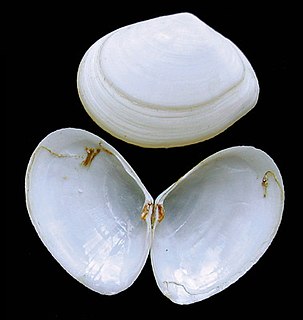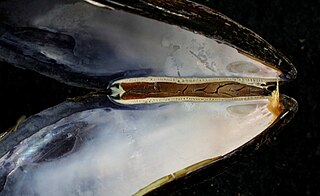
A seashell or sea shell, also known simply as a shell, is a hard, protective outer layer usually created by an animal that lives in the sea. The shell is part of the body of the animal. Empty seashells are often found washed up on beaches by beachcombers. The shells are empty because the animal has died and the soft parts have been eaten by another animal or have decomposed.

Bivalvia, in previous centuries referred to as the Lamellibranchiata and Pelecypoda, is a class of marine and freshwater molluscs that have laterally compressed bodies enclosed by a shell consisting of two hinged parts. Bivalves as a group have no head and they lack some usual molluscan organs like the radula and the odontophore. They include the clams, oysters, cockles, mussels, scallops, and numerous other families that live in saltwater, as well as a number of families that live in freshwater. The majority are filter feeders. The gills have evolved into ctenidia, specialised organs for feeding and breathing. Most bivalves bury themselves in sediment where they are relatively safe from predation. Others lie on the sea floor or attach themselves to rocks or other hard surfaces. Some bivalves, such as the scallops and file shells, can swim. The shipworms bore into wood, clay, or stone and live inside these substances.

The Rostroconchia is a class of extinct molluscs dating from the early Cambrian to the Late Permian. They were initially thought to be bivalves, but were later given their own class. They have a single shell in their larval stage, and the adult typically has a single, pseudo-bivalved shell enclosing the mantle and muscular foot. The anterior part of the shell probably pointed downward and had a gap from which the foot could probably emerge. Rostroconchs probably lived a sedentary semi-infaunal lifestyle. There were probably more than 1,000 species of members of this class.

Ark clam is the common name for a family of small to large-sized saltwater clams or marine bivalve molluscs in the family Arcidae. Ark clams vary both in shape and size. They number about 200 species worldwide.
Sphaerium nucleus is a freshwater bivalve of the family Sphaeriidae. It has been often confused with Sphaerium corneum and is consequently quite poorly known.
A mollusc valve is each articulating part of the shell of a mollusc. Each part is known as a valve or in the case of chitons, a "plate". Members of two classes of molluscs, the Bivalvia (clams) and the Polyplacophora (chitons), have valves.

A bivalve shell is part of the body, the exoskeleton or shell, of a bivalve mollusk. In life, the shell of this class of mollusks is composed of two hinged parts or valves. Bivalves are very common in essentially all aquatic locales, including saltwater, brackish water, and freshwater. The shells of bivalves commonly wash up on beaches and along the edges of lakes, rivers, and streams. Bivalves by definition possess two shells or valves, a "right valve" and a "left valve", that are joined by a ligament. The two valves usually articulate with one another using structures known as "teeth" which are situated along the hinge line. In many bivalve shells, the two valves are symmetrical along the hinge line—when truly symmetrical, such an animal is said to be equivalved; if the valves vary from each other in size or shape, inequivalved. If symmetrical front-to-back, the valves are said to be equilateral, and are otherwise considered inequilateral.

Juliidae, common name the bivalved gastropods, is a family of minute sea snails, marine gastropod mollusks or micromollusks in the superfamily Oxynooidea, an opisthobranch group.

Julia exquisita is a species of very small sea snail with a shell comprising two separate hinged pieces or valves. It is a marine gastropod mollusk in the family Juliidae.
Concavodonta is an extinct genus of early bivalve in the extinct family Praenuculidae. The genus is one of three genera in the subfamily Concavodontinae. Concavodonta is known solely from late Ordovician, Caradoc epoch, fossils found in Europe and South America. The genus currently contains three accepted species, Concavodonta imbricata, Concavodonta ovalis and the type species Concavodonta ponderata.
Hemiconcavodonta is an extinct genus of bivalve in the extinct family Praenuculidae. The genus is one of three genera in the subfamily Concavodontinae. Hemiconcavodonta is known solely from late Ordovician, Caradoc epoch, fossils found in South America. The genus currently contains a single accepted species, Hemiconcavodonta minuta.
Villicumia is an extinct genus of bivalve in the extinct family Praenuculidae. The genus is one of eleven genera in the subfamily Praenuculinae. It is one of three Praenuculinae genera known solely from late Ordovician, Caradoc epoch, fossils found in South America. Villicumia currently contains a single accepted species, Villicumia canteraensis.

The umbo is the vaguely defined, often most prominent, highest part of each valve of the shell of a bivalve or univalve mollusc. It usually contains the valve's beak, the oldest point of the valve, and its degree of prominence and its position relative to the hinge line are sometimes helpful in distinguishing bivalve taxa. The umbo forms while the animal is a juvenile, and radial growth subsequently proceeds around that area. The umbo is situated above the hinge line. In those bivalves where the umbones do not protrude, as is the case for example in some mussels, the umbones can nonetheless usually be readily identified by examining the concentric growth lines of the shell.

Hinge teeth are part of the anatomical structure of the inner surface of a bivalve shell, i.e. the shell of a bivalve mollusk. Bivalves by definition have two valves, which are joined together by a strong and flexible ligament situated on the hinge line at the dorsal edge of the shell. In life, the shell needs to be able to open slightly to allow the foot and siphons to protrude, and then close again, without the valves moving out of alignment with one another. To make this possible, in most cases the two valves are articulated using an arrangement of structures known as hinge teeth. Like the ligament, the hinge teeth are also situated along the hinge line of the shell, in most cases.

A hinge line is an imaginary longitudinal line along the dorsal edge of the shell of a bivalve mollusk where the two valves hinge or articulate. The hinge line can easily be perceived in these images of a mussel shell and an ark shell.

A resilifer is a part of the shell of certain bivalve mollusks. It is either a recess or a process, the function of which is the attachment of an internal ligament, which holds the two valves together.

A prodissoconch is an embryonic or larval shell which is present in the larva of a bivalve mollusk. The prodissoconch is often but not always smooth, and has no growth lines. It is sometimes still present and visible in the adult shell, if there has been no erosion of the shell in that area.

A hinge ligament is a crucial part of the anatomical structure of a bivalve shell, i.e. the shell of a bivalve mollusk. The shell of a bivalve has two valves and these are joined together by the ligament at the dorsal edge of the shell. The ligament is made of a strong, flexible and elastic, fibrous, proteinaceous material which is usually pale brown, dark brown or black in color.

The adductor muscles are the main muscular system in bivalve mollusks. In many parts of the world, when people eat scallops, the adductor muscles are the only part of the soft parts of the animal which are eaten. Adductor muscles leave noticeable scars or marks on the interior of the shell's valves. Those marks are often used by scientists who are in the process of identifying empty shells to determine their correct taxonomic placement.












